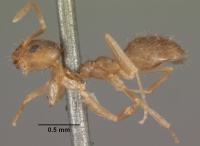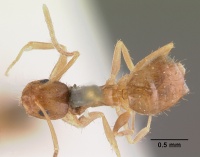Nylanderia vividula
| Nylanderia vividula | |
|---|---|

| |
| Scientific classification | |
| Kingdom: | Animalia |
| Phylum: | Arthropoda |
| Class: | Insecta |
| Order: | Hymenoptera |
| Family: | Formicidae |
| Subfamily: | Formicinae |
| Tribe: | Lasiini |
| Genus: | Nylanderia |
| Species: | N. vividula |
| Binomial name | |
| Nylanderia vividula (Nylander, 1846) | |
| Subspecies | |
| |
| Synonyms | |
| |
Nests are found in a wide variety of habitats across the Nearctic, ranging from under stones in forests to urban environments. Substrates can include everything from fine sandy clay to damp potting soil. The adaptive nature of this species translates into its distribution across much of the Nearctic region of the United States and Mexico. Reproductives may fly year round, given it is sufficiently warm and humid, and males are usually present in the nest (Trager, 1984) (Kallal & LaPolla, 2012). Pashaei Rad et al. (2018) found this species in Iran on parkland ground in a moderate rainfall area.
| At a Glance | • Highly invasive |
Identification
Kallal & LaPolla (2012) - Usually brown and bicolored with head and gaster darker than mesosoma, and lighter mesosoma and legs; sparse pubescence on head; head square in shape.
Compare with: Nylanderia austroccidua, Nylanderia concinna, Nylanderia flavipes, and Nylanderia terricola.
Nylanderia vividula is one of the few species that is found in both the eastern and western United States and Mexico. The species varies in overall coloration from brownish yellow to dark brown, and its mesocoxae and metacoxae color range from being the same color as the mesosoma to being pale and contrasting with its body. This makes the species easily confused with multiple other species with which it occurs sympatrically. In particular, the workers of N. vividula and N. terricola are nearly indistinguishable from each other. The only possible way to morphologically distinguish them is by head shape and relative eye size, but even these features are not always reliable. N. vividula has a squarer head with close to parallel lateral margins in full face view while N. terricola has more convex lateral margins, resulting in a slightly oval appearance. Regarding eye size, the length of the eye relative to the head length (ocular index) in N. vividula is usually more than that of N. terricola, with the latter infrequently exceeding 24 (Trager, 1984). But in both of these morphological features there is broad overlap.
In California, N. terricola is paler than N. vividula, and is often found in natural, arid habitations rather than disturbed ones (P. Ward, pers. comm.). Additionally, an index of eye length divided by scape length is often lower in N. terricola versus N. vividula. It should be noted that while these are useful in California, they do not seem to apply elsewhere where the two species’ ranges overlap.
Ultimately, males are best used to separate the species. N. vividula parameres curve inward, especially evident when viewed dorsally, and lack distally digitiform structure found in N. terricola. Additionally, the digiti and aedeagal valves do not taper then expand into broad tips, as they do in N. terricola. The ninth sternites are also very different. In N. vividula, it is triangular, growing wider proximally, whereas the ninth sternite is short and broad in N. terricola.
In the eastern United States, N. vividula may be confused with N. concinna and N. flavipes. However, both of these have dense head pubescence, which N. vividula lacks. N. concinna is not bicolored and has brown, rather than yellowish, scapes. N. flavipes is bicolored, but the presence of apparent ocelli usually indicates it is not N. vividula. In the western U.S. and Mexico, N. austroccidua may be bicolored with lighter legs and scapes, but its dense head pubescence, bluish reflections under microscopic examination, and angular pronotum are not found in N. vividula.
Keys including this Species
- Key to Afrotropical Nylanderia workers
- Key to Nearctic Nylanderia Males
- Key to Nearctic Nylanderia Workers
Distribution
Known from North America, Central America, Europe and Africa.
It is notable that this is probably the only native Nearctic species to be found outside the Nearctic region. Its type locality is in Europe, and collections have been cited in both Africa and the Neotropics (Kallal & LaPolla, 2012).
Latitudinal Distribution Pattern
Latitudinal Range: 39.984329° to -20.753°.
| North Temperate |
North Subtropical |
Tropical | South Subtropical |
South Temperate |
- Source: AntMaps
Distribution based on Regional Taxon Lists
Afrotropical Region: United Arab Emirates.
Indo-Australian Region: Solomon Islands.
Malagasy Region: Mauritius, Seychelles.
Nearctic Region: United States (type locality).
Neotropical Region: Bermuda (type locality), Brazil, Cuba, Haiti, Mexico, Puerto Rico, Trinidad and Tobago, Venezuela.
Oriental Region: India, Sri Lanka.
Palaearctic Region: Balearic Islands, China, Croatia, Finland (type locality), Greece, Hungary, Iran, Russian Federation, Spain, Sweden (type locality), Türkiye, United Kingdom of Great Britain and Northern Ireland.
Distribution based on AntMaps
Distribution based on AntWeb specimens
Check data from AntWeb
Countries Occupied
| Number of countries occupied by this species based on AntWiki Regional Taxon Lists. In general, fewer countries occupied indicates a narrower range, while more countries indicates a more widespread species. |
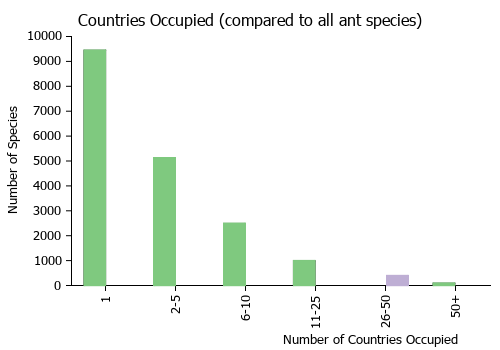
|
Biology
In New Mexico (Mackay and Mackay 2002) - Occurs in open, disturbed areas, urban habitats, greenhouses, and grasslands in the Chihuahuan Desert. These ants nest in the soil, often under a stone. Brood was present in April and July. Alates were present throughout the year and fly on any warm day with high humidity. Most flights occur from May to October, between 18:00 and 22:00. Females are attracted to lights, even though flights occur during daylight.
Hab. in caldariis temperaturae circ. + 25 C. horti botanici Helsingforsicnsis frequenter, Coccos plantarum avide investigans; agilissime cursitans, pavida. Nidificat in rimis caementi parietum et pavimentorum. Coit auctumno a fine m. Augusti ad Octobr. et Novembr.; inveniuntur tamen saltem mares usque ad initium anni sequeutis parcius. Paria copula juncta in parietibus caldariorum currentia vidi. E Rossia verisimiliter cum plautis hibernaculariis advecta est haec species, mitioris coeli primitus incola. A temperatura parum frigida cito soporatur. (Nylander 1846)
Regional Notes
Borowiec and Salata (2022), Greece - Invasive thermophilous species, noted from tourist resorts. Inhabits ruderal areas, grasslands and parks. Nests in cavities in plants and trees, rotten wood, and in soil. Workers are omnivorous, feeding on live and dead insects, seeds, honeydew, fruits, plant exudates, and many household foods. All records are from low altitude from sea level to 155 m.
Flight Period
| X | X | ||||||||||
| Jan | Feb | Mar | Apr | May | Jun | Jul | Aug | Sep | Oct | Nov | Dec |
Source: antkeeping.info.
- Check details at Worldwide Ant Nuptial Flights Data, AntNupTracker and AntKeeping.
 Explore: Show all Flight Month data or Search these data. See also a list of all data tables or learn how data is managed.
Explore: Show all Flight Month data or Search these data. See also a list of all data tables or learn how data is managed.
Association with Other Organisms
 Explore: Show all Associate data or Search these data. See also a list of all data tables or learn how data is managed.
Explore: Show all Associate data or Search these data. See also a list of all data tables or learn how data is managed.
Fungi
This species is a host for the fungus Myrmicinosporidium durum (a pathogen) in United States (Pereira, 2004; Espadaler & Santamaria, 2012).
Castes
Worker
Images from AntWeb
   
| |
| Worker. Specimen code casent0059600. Photographer April Nobile, uploaded by California Academy of Sciences. | Owned by CAS, San Francisco, CA, USA. |
   
| |
| Paralectotype of Formica vividula. Worker. Specimen code casent0102538. Photographer April Nobile, uploaded by California Academy of Sciences. | Owned by UZMH, Helsinki, Finland. |
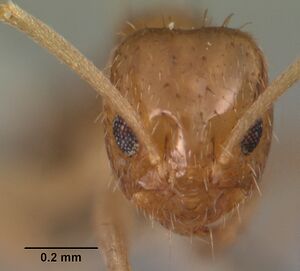    
| |
| Paralectotype of Formica vividula. Worker. Specimen code casent0102539. Photographer April Nobile, uploaded by California Academy of Sciences. | Owned by UZMH, Helsinki, Finland. |
 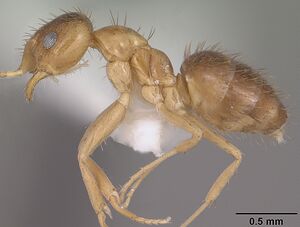 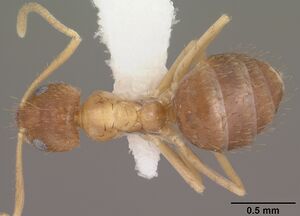
| |
| Worker. Specimen code casent0102821. Photographer April Nobile, uploaded by California Academy of Sciences. | Owned by CAS, San Francisco, CA, USA. |
   
| |
| Worker. Specimen code casent0104260. Photographer April Nobile, uploaded by California Academy of Sciences. | Owned by ABS, Lake Placid, FL, USA. |
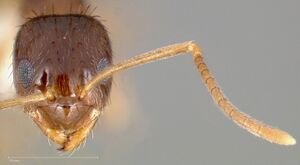   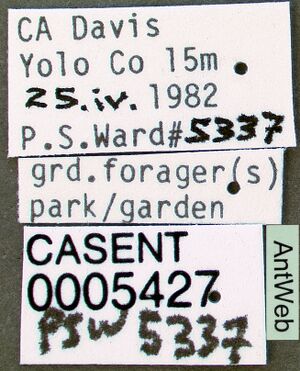
| |
| Worker. Specimen code casent0005427. Photographer April Nobile, uploaded by California Academy of Sciences. | Owned by UCDC, Davis, CA, USA. |
Queen
Images from AntWeb
   
| |
| Queen (alate/dealate). Specimen code casent0058913. Photographer April Nobile, uploaded by California Academy of Sciences. | Owned by CAS, San Francisco, CA, USA. |
   
| |
| Paralectotype of Formica vividula. Queen (alate/dealate). Specimen code casent0102537. Photographer April Nobile, uploaded by California Academy of Sciences. | Owned by UZMH, Helsinki, Finland. |
Male
Images from AntWeb
    
| |
| Male (alate). Specimen code casent0058918. Photographer April Nobile, uploaded by California Academy of Sciences. | Owned by CAS, San Francisco, CA, USA. |
  
| |
| Lectotype of Formica vividula. Male (alate). Specimen code casent0102536. Photographer April Nobile, uploaded by California Academy of Sciences. | Owned by UZMH, Helsinki, Finland. |
Nomenclature
The following information is derived from Barry Bolton's Online Catalogue of the Ants of the World.
- vividula. Formica vividula Nylander, 1846a: 900, pl. 18, figs. 2, 10-14 (w.q.m.) FINLAND. Combination in Prenolepis: Mayr, 1861: 52; in Pr. (Nylanderia): Emery, 1906b: 134; in Paratrechina (Nylanderia): Emery, 1925b: 223; in Nylanderia: Kempf, 1972a: 168; in Paratrechina: Trager, 1984b: 131; in Nylanderia: LaPolla, Brady & Shattuck, 2010a: 127. Senior synonym of picea: Mayr, 1876: 78; Mayr, 1886d: 431; of kincaidi Trager, 1984b: 75; of mjobergi: Kallal & LaPolla, 2012: 38. Current subspecies: nominal plus australis. See also: Emery, 1910a: 131; Radchenko, 2007: 33.
- picea. Formica picea Buckley, 1866: 163 (w.) U.S.A. Junior synonym of vividula: Mayr, 1876: 78; Mayr, 1886d: 431. See also: Smith, D.R. 1979: 1444.
- kincaidi. Prenolepis kincaidi Wheeler, W.M. 1906e: 350, fig. 1 (w.q.m.) BERMUDA. Combination in Paratrechina (Nylanderia): Emery, 1925b: 222; in Nylanderia: Kempf, 1972a: 167. Junior synonym of vividula: Trager, 1984b: 75.
- mjobergi. Prenolepis (Nylanderia) vividula var. mjobergi Forel, 1908b: 64 (w.) SWEDEN. Combination in Paratrechina (Nylanderia): Emery, 1925b: 223; in Nylanderia: LaPolla, Brady & Shattuck, 2010a: 127. Junior synonym of vividula: Kallal & LaPolla, 2012: 38.
Type Material
- Formica vividula: Lectotype, male, Helsinki [Helsingfors] Botanical Garden, Finland, 2–25 October 1845, Helsinki Museum.
- Formica picea: Syntype, worker, Austin, Travis County, Texas, United States.
- Prenolepis kincaidi: Syntype, worker(s), queen(s), male(s), Bermuda, 32°19′0″N 64°45′0″W / 32.316667°N 64.75°W, 26 June 1906, Kincaid, Museum of Comparative Zoology.
- Prenolepis vividula mjobergi: Lectotype, worker, Stockholm (in greenhouse), Sweden, Musee d'Histoire Naturelle Genève.
Unless otherwise noted the text for the remainder of this section is reported from the publication that includes the original description.
Kallal & LaPolla (2012) - Syntypes of N. vividula antillana were examined (4 specimens from Musee d'Histoire Naturelle Genève and found to match the syntype material available for N. guatemalensis, hence our decision to consider it a synonym of the latter species (see synoptic list of species). Syntypes of N. vividula australis Santschi (1929) examined (6 specimens from Naturhistorisches Museum, Basel) revealed a species that is certainly not N. vividula, but its status is difficult to assess until completion of on-going revisionary work of the Neotropical Nylanderia fauna.
Description
Worker
Long. ¾ - 1 lin. nitida, ore cum mandibulis, capite infra, thorace subtus et pedibus sordide testaceis; capite supra lateribusque et abdomine fuscis; thorace quoque supra fusco, sed dilutiori h. e. colore testaceo magis interlucente. Setae fuscae sat validae in capite, pro- et mesonoto (pulvinar eommune efficientibus) atque in abdomine conspersae, in abdomine tamen crebriores quam in cetero corpore. Autennae graciles long. fere ¾ lin. Laminal frontalis inter antennas vestigia solum obsoleta, marginibus scilicet nullis, fronteque aequaliter convexiuscula inter radice antennarum pauxillum tentum tumidiuscula. Ocelli nulli. Abdomen setosum magnitudinem capitis vix superans, ovatum.
Kallal & LaPolla (2012) - Measurements (n=25) TL: 1.92–2.82; HW: 0.47–0.65; HL: 0.56–0.66; EL: 0.13–0.19; SL: 0.62–0.74; PW: 0.34–0.50; WL: 0.63–0.98; GL: 0.71–1.18; PH: 0.16–0.29; PFL: 0.49–0.74; PFW: 0.14–0.19. SMC: 4–14; PMC: 2–8; MMC: 1–4. Indices: CI: 79–93; REL: 21–30; SI: 92–122; FI: 86–110.
Overall the worker description for N. vividula matches the description of Nylanderia terricola. The difference between workers of these two species is slight and not always morphologically consistent. The main difference is that N. vividula possesses a head with lateral margins that are subparellel, giving the head a slightly squarer appearance in comparison to N. terricola.
Borowiec and Salata (2022) - Large, HL: 0.627-0.714 (mean 0.676); HW: 0,444-0.524 (mean 0.483); SL: 1.063-1.222 (mean 1.138); EL: 0.178-0.222 (mean 0.197); ML: 0.93-1.06; MW: 0.34- 0.40. Color. Body uniformly yellowish brown to dark brown, mandibles, antennae, and legs yellow, only in the darkest forms legs slightly infuscate. Head. Approximately 1.4 times longer than wide, sides almost parallel, occipital margin softly convex. Clypeus with diffused microreticulation, appears almost smooth and shiny, transverse, its anterior margin almost straight with shallow median emargination, posterior margin concave in the middle, clypeal surface with sparse and short appressed white pubescence, a row of long yellow setae at anterior margin and mixed short and long erected setae, the longest with length 0.152. Whole head with diffused microreticulation but appears shiny, with rudiments of sparse and short white appressed hairs and numerous very long, yellowish white, semierect to erected setae, the shortest on gena, the longest in interocular and occipital area, the longest with length 0.183. Ventral sides of head with several, long, white erected setae grouping mostly on sides of gular area. Scape very long, 2.31-2.41 times longer than width of head, only slightly widened from base to apex, its surface microreticulate but shiny with very short and sparse appressed pubescence, erected setae absent or at most in apical third of frontal edge with single, short erect seta. Funicular segments elongate, thin, the second funicular segment approximately 2.2 times as long as wide, slightly shorter than first and distinctly shorter than third segment, the rest of funicular segments very long, clearly longer than broad. Eyes big, distinctly longer than wide, 0.29 length of head. Mandibles elongate, without longitudinal sculpture. Mesosoma. Strongly elongate, softly constricted in the middle, 2.4-2.8 times as long as wide, surface without appressed pubescence, with diffused microreticulation, appears slightly opaque. In lateral view promesonotum almost linear, metanotal groove very shallow, propodeum elongate, softly convex. The whole surface of promesonotum with numerous, very long, white or yellowish white erected setae, as long as the longest setae on head, propodeum without setae. Waist and gaster. Petiole small, in form of thick scale with rounded apex, without setae in anterolateral corners. Gaster shorter than mesosoma, surface of tergites distinctly microreticulated, without appressed pubescence, appears slightly opaque, each tergite with numerous very long, white to yellowish erected setae, the longest with length 0.190. Legs thin and elongate, femora distinctly longer than gaster. Legs. Elongate, surface of femora and tibiae with several semierect white setae.
Queen
Long. 1 1/2 lin. cinereo-micans, abdomine fusco, capite supra parum fuscescente, cetero corpore sordide testaceo. Caput fere ut in regina, scil. a latere visum ovalum; oculi parum prominuli, clypeus nitidus tumidulus in medio longitrorsum elevatus; sed differt lamina frontali parum distinctiori, antennis paulo validioribus licet ejusdem longitudinis, ocellis et canitie levi, certo situ micante. Scutellum deplanatum semicirculare. Melathorax postice declivis et squama nitentes; squama latere postico multo minus inclinato quam in regina; parum concaviusculo, margine supero subtilissime (microscopice) albo-setuloso medioque leviter emarginato Alae anticae long. 1 1/2 lin. Abdomen longitudine capitis thoracisque, thorace fere duplo latius, selis (ut etiam ceterum corpus), sed minoribus quam in regina, conspersum. Venter basi saepe pallescit.
Kallal & LaPolla (2012) - Measurements (n=4) TL: 3.83–4.04; HW: 0.74–0.78; HL: 0.76–0.96; EL: 0.26–0.28; SL: 0.73–0.79; PW: 0.83–0.92; MW: 0.78–0.80; WL: 1.14–1.31; GL: 1.86–2.05; PH: 0.39–0.44; PFL: 0.69–0.74; PFW: 0.19–0.22. SMC: 4–10; PMC: 4–6; MMC: 3–10; MtMC: 2. Indices: CI: 77–96; REL: 29–33; SI: 76–99; FI: 77–94.
Brown in color, with scapes, mandibles, and leg joints yellowish; mesosoma sometimes lighter brown than head and gaster; cuticle smooth and shiny; body with dense pubescence; macrosetae brown. Head usually longer than broad; scapes surpass posterior margins by first 3–4 funicular segments. Propodeum with short dorsal face and long declivitous face.
Male
Long. 3/4 lin. nitidus fuscus; ore, articulationibus pedum, tarsis et genitalibus testaceis. Setae corporis fere ut in regina. Alae ut in diagnosi feminae; anticae long. 3/4 lin. Squama parva sursum rotundato-quadrata, postice concaviuscula. Abdomen (supra visum) circulare, longitudine vix thoracis. Appendices genitalium vaginis externis angustis distantibus intus curvatis flavido-pilosis, internis tenuibus rectis.
Kallal & LaPolla (2012) - Measurements (n=9) TL: 1.79–2.15; HW: 0.46–0.53; HL: 0.46–0.55; EL: 0.19–0.23; SL: 0.52–0.69; PW: 0.46–0.51; MW: 0.40–0.54; WL: 0.70–0.78; GL: 0.62–0.87; PH: 0.12–0.29; PFL: 0.49–0.57; PFW: 0.10–0.18; PL: 0.20–0.33. SMC: 1–5; MMC: 4–10; MTMC: 2–3. Indices: CI: 74–102; REL: 36–43; SI: 101–125; FI: 92–112.
Overall brown in color, with yellowish-brown scapes, mandibles, and leg joints; mesocoxae and metacoxae sometimes lighter; cuticle smooth and shiny; cephalic, mesosoma pubescent dorsally, except pronotum; gastral pubescence virtually absent; macrosetae brown. Head slightly longer than broad; eyes convex, extending beyond the lateral margins of the head in full face view; antennae bent around segment IV; scapes surpass posterior margin by first 3–4 funicular segments; inner mandibular margin long and straight; basal angle approximately 90°; masticatory margin with one subapical tooth and large apical tooth, sometimes with additional denticles. Mesosoma enlarged to accommodate flight muscles; in lateral view, pronotal margin short and straight; propodeum with equally long dorsal and declivitous faces. Genitalia: parameres laterally oriented, triangular, curving inward distally; digiti angled ventrally; cuspides reaching about half the length of the digiti, both with rounded teeth where they meet; aedeagal valve triangular, teeth absent; ninth sternite becoming broader into a triangular shape proximally, with thin, blunt-ended lateral apodemes and a long ventral apodeme.
References
- Albuquerque, E., Prado, L., Andrade-Silva, J., Siqueira, E., Sampaio, K., Alves, D., Brandão, C., Andrade, P., Feitosa, R., Koch, E., Delabie, J., Fernandes, I., Baccaro, F., Souza, J., Almeida, R., Silva, R. 2021. Ants of the State of Pará, Brazil: a historical and comprehensive dataset of a key biodiversity hotspot in the Amazon Basin. Zootaxa 5001, 1–83 (doi:10.11646/zootaxa.5001.1.1).
- Báthori, F., Herczeg, G., Vilizzi, L., Jégh, T., Kakas, C., Petrovics, M., Csősz, S. 2024. A survey and risk screening of non-native ant species colonising greenhouses in Hungary. Biological Invasions (doi:10.1007/s10530-023-03227-9).
- Borowiec, L. 2014. Catalogue of ants of Europe, the Mediterranean Basin and adjacent regions (Hymenoptera: Formicidae). Genus (Wroclaw) 25(1-2): 1-340.
- Borowiec, L., Salata, S. 2022. A monographic review of ants of Greece (Hymenoptera: Formicidae). Vol. 1. Introduction and review of all subfamilies except the subfamily Myrmicinae. Part 1: text. Natural History Monographs of the Upper Silesian Museum 1: 1-297.
- Davis, T. 2009. The ants of South Carolina (thesis, Clemson University).
- Donisthorpe, H. 1946i. The ants (Hym. Formicidae) of Mauritius. Ann. Mag. Nat. Hist. 11(13): 25-35 (see also)
- Dubovikoff, D.A., Yusupov, Z.M. 2017. Family Formicidae - Ants. In Belokobylskij S. A. and A. S. Lelej: Annotated catalogue of the Hymenoptera of Russia. Proceedingss of the Zoological Institute of the Russian Academy of Sciences 6: 197-210.
- Emery, C. 1906b. Note sur Prenolepis vividula Nyl. et sur la classification des espèces du genre Prenolepis. Ann. Soc. Entomol. Belg. 50: 130-134 (page 134, Combination in Pr. (Nylanderia))
- Emery, C. 1910a. Beiträge zur Monographie der Formiciden des paläarktischen Faunengebietes. (Hym.) Teil X. Dtsch. Entomol. Z. 1910: 127-132 (page 131, see also)
- Emery, C. 1925d. Hymenoptera. Fam. Formicidae. Subfam. Formicinae. Genera Insectorum 183: 1-302 (page 223, Combination in Paratrechina (Nylanderia))
- Espadaler, X., Santamaria, S. 2012. Ecto- and Endoparasitic Fungi on Ants from the Holarctic Region. Psyche Article ID 168478, 10 pages (doi:10.1155/2012/168478).
- Fontenla, J.L., Brito, Y.M. 2011. Hormigas invasoras y vagabundas de Cuba. Fitosanidad 15(4), 253-259.
- Hill, J.G. 2015. Ants (Hymenoptera: Formicidae) of the Big Thicket Region of Texas. Midsouth Entomologist 8: 24-34.
- Ivanov, K. 2019. The ants of Ohio (Hymenoptera, Formicidae): an updated checklist. Journal of Hymenoptera Research 70: 65–87 (doi:10.3897@jhr.70.35207).
- Kallal, R.J. & LaPolla, J.S. 2012. Monograph of Nylanderia (Hymenoptera: Formicidae) of the World, Part II: Nylanderia in the Nearctic. Zootaxa 3508, 1-64.
- Karaman, C., Kıran, K. 2018. New tramp ant species for Turkey: Tetramorium lanuginosum Mayr (Hymenoptera: Formicidae). Trakya University Journal of Natural Sciences 19(1), e1-e4 (doi:10.23902/trkjnat.340008).
- Kempf, W. W. 1972b. Catálogo abreviado das formigas da regia~o Neotropical. Stud. Entomol. 15: 3-344 (page 168, Combination in Nylanderia)
- Kiran, K., Karaman, C. 2020. Additions to the ant fauna of Turkey (Hymenoptera, Formicidae). Zoosystema 42(18), 285-329 (doi:10.5252/zoosystema2020v42a18).
- Laciny, A. 2021. Among the shapeshifters: parasite-induced morphologies in ants (Hymenoptera, Formicidae) and their relevance within the EcoEvoDevo framework. EvoDevo 12, 2 (doi:10.1186/s13227-021-00173-2).
- Latumahina, F., Borovanska, M., Musyafa, Sumardi, Susetya Putra, N., Janda, M. 2015. Ants of Ambon Island – diversity survey and checklist. ZooKeys 472, 43–57 (doi:10.3897/zookeys.472.8441).
- Liu, C., Fischer, G., Hita Garcia, F., Yamane, S., Liu, Q., Peng, Y.Q., Economo, E.P., Guénard, B., Pierce, N.E. 2020. Ants of the Hengduan Mountains: a new altitudinal survey and updated checklist for Yunnan Province highlight an understudied insect biodiversity hotspot. ZooKeys 978, 1–171 (doi:10.3897/zookeys.978.55767).
- Lubertazzi, D. 2019. The ants of Hispaniola. Bulletin of the Museum of Comparative Zoology, 162(2), 59-210 (doi:10.3099/mcz-43.1).
- MacGown, J.A., Booher, D., Richter, H., Wetterer, J.K., Hill, J.G. 2021. An updated list of ants of Alabama (Hymenoptera: Formicidae) with new state records. Transactions of the American Entomological Society 147: 961-981 (doi:10.3157/061.147.0409).
- Mackay, W. P. and E. Mackay. 2002. The ants of New Mexico (Hymenoptera: Formicidae). Edwin Mellen Press, Lewiston, NY.
- Mamet, R. 1954. The ants (Hymenoptera Formicidae) of the Mascarene Islands. Mauritius Inst. Bull. 3: 249-259 (see also)
- Mayr, G. 1861. Die europäischen Formiciden. Nach der analytischen Methode bearbeitet. Wien: C. Gerolds Sohn, 80 pp. (page 52, Combination in Prenolepis)
- Mayr, G. 1876. Die australischen Formiciden. J. Mus. Godeffroy 12: 56-115 (page 78, Senior synonym of picea)
- Mayr, G. 1886d. Die Formiciden der Vereinigten Staaten von Nordamerika. Verh. K-K. Zool.-Bot. Ges. Wien 36: 419-464 (page 431, Senior synonym of picea)
- Nylander, W. 1846a. Adnotationes in monographiam formicarum borealium Europae. Acta Societatis Scientiarum Fennicae. 2:875-944. (page 900, pl. 18, figs. 2, 10-14 worker, queen, male described)
- Pashaei Rad, S., Taylor, B., Torabi, R., Aram, E., Abolfathi, G., Afshari, R., Borjali, F., Ghatei, M., Hediary, F., Jazini, F., Heidary Kiah, V., Mahmoudi, Z., Safariyan, F., Seiri, M. 2018. Further records of ants (Hymenoptera: Formicidae) from Iran. Zoology in the Middle East 64, 145-159 (doi:10.1080/09397140.2018.1442301).
- Pereira, R.M. 2004. Occurrence of Myrmicinosporidium durum in red imported fire ant, Solenopsis invicta, and other new host ants in eastern United States. Journal of Invertebrate Pathology 86: 38-44 (doi:10.1016/j.jip.2004.03.005).
- Rafiqi, A.M., Rajakumar, A., Abouheif, E. 2020. Origin and elaboration of a major evolutionary transition in individuality. Nature 585, 239–244. (doi:10.1038/s41586-020-2653-6).
- Trager, J. C. 1984b. A revision of the genus Paratrechina (Hymenoptera: Formicidae) of the continental United States. Sociobiology 9: 49-162 (page 131, Combination in Paratrechina, Senior synonym of kincaidi)
- Wetterer, J.K. 2017. Invasive ants of Bermuda revisited. Journal of Hymenoptera Research 54, 33–41 (doi:10.3897/jhr.54.11444).
- Williams, J.L., Zhang, Y.M., Lloyd, M.W., LaPolla, J.S., Schultz, T.R., Lucky, A. 2020. Global domination by crazy ants: phylogenomics reveals biogeographical history and invasive species relationships in the genus Nylanderia (Hymenoptera: Formicidae). Systematic Entomology 45, 730–744 (doi:10.1111/syen.12423).
References based on Global Ant Biodiversity Informatics
- Alayo D. P. 1974. Introduccion al estudio de los Himenopteros de Cuba. Superfamilia Formicoidea. Academia de Ciencias de Cuba. Instituto de Zoologia. Serie Biologica no.53: 58 pp. La Habana.
- Brandao, C.R.F. 1991. Adendos ao catalogo abreviado das formigas da regiao neotropical (Hymenoptera: Formicidae). Rev. Bras. Entomol. 35: 319-412.
- Cokendolpher J. C., and O. F. Francke. 1990. The ants (Hymenoptera, Formicidae) of western Texas. Part II. Subfamilies Ecitoninae, Ponerinae, Pseudomyrmecinae, Dolichoderinae, and Formicinae. Special Publications, the Museum. Texas Tech University 30:1-76.
- Cokendolpher J.C., Reddell J.R., Taylor S.J, Krejca J.K., Suarez A.V. and Pekins C.E. 2009. Further ants (Hymenoptera: Formicidae) from caves of Texas [Hormigas (Hymenoptera: Formicdae) adicionales de cuevas de Texas]. Texas Memorial Museum Speleological Monographs, 7. Studies on the cave and endogean fauna of North America, V. Pp. 151-168
- Cook J. L. 2003. Conservation of biodiversity in an area impacted by the red imported fire ant, Solenopsis invicta (Hymenoptera: Formicidae). Biodiversity and Conservation 12: 187195.
- Coronado-Blanco J. M., D. A. Dubovikoff, E. Ruiz-Cancino, M. Vasquez-Bolanos, K. Y. Flores-Maldonado, and J. V. Horta-Vega. 2013. Formicidae (Hymenoptera) del estado de Tamaulipas, Mexico. CienciaUat 25(1): 12-17.
- Cover S. P., and R. A. Johnson. 20011. Checklist of Arizona Ants. Downloaded on January 7th at http://www.asu.edu/clas/sirgtools/AZants-2011%20updatev2.pdf
- Culver D. C. 1974. Species packing in Caribbean and North Temperate ant communities. Ecology 55(5): 974-988.
- Dash S. T. and L. M. Hooper-Bui. 2008. Species diversity of ants (Hymenoptera: Formicidae) in Louisiana. Conservation Biology and Biodiversity. 101: 1056-1066
- Dean D. A., and S. R. Dean. 2018. A survey of the ant fauna and seasonal alate nuptial flights at two locations in South-Central Texas. Southwestern Entomologist 43(3): 639-647.
- Deyrup M., C. Johnson, G. C. Wheeler, J. Wheeler. 1989. A preliminary list of the ants of Florida. Florida Entomologist 72: 91-101
- Deyrup, M. 2003. An updated list of Florida ants (Hymenoptera: Formicidae). Florida Entomologist 86(1):43-48.
- Deyrup, M. and J. Trager. 1986. Ants of the Archbold Biological Station, Highlands County, Florida (Hymenoptera: Formicidae). Florida Entomologist 69(1):206-228
- Deyrup, M., L. Davis, S. Cover. 2000. Exotic ants in Florida. Transactionc of the American Entomological Society 126(3+4): 293-326
- Fernandez Triana J. L., H. Sariol, M. A. Vega Castillo, S. Ricardo, M. Gonzalez, and E. P. Ferrer. 2002. Datos preliminares dobre la biodiversidad del orden Hymenoptera en la provincia Granma, Cuba. Bol. S.E.A. 31: 43-48.
- Fernández, F. and S. Sendoya. 2004. Lista de las hormigas neotropicales. Biota Colombiana Volume 5, Number 1.
- Fontanla Rizo J.L. 1997. Lista preliminar de las hormigas de Cuba. Cocuyo 6: 18-21.
- Fontenla J. L., and J. Alfonso-Simonetti. 2018. Classification of Cuban ants (Hymenoptera: Formicidae) into functional groups. Poeyana Revista Cubana de Zoologia 506: 21-30.
- Fontenla Rizo J. L. 1993. Mirmecofauna de Isla de la Juventud y de algunos cayos del archipielago cubano. Poeyana. Instituto de Ecologia y Sistematica, Academia de Ciencias de Cuba 444:1-7.
- Fontenla Rizo J. L. 1997. Lista preliminar de las hormigas de Cuba (Hymenoptera: Formicidae). Cocuyo 6: 18-21.
- Forel A. 1908. Ameisen aus Sao Paulo (Brasilien), Paraguay etc. gesammelt von Prof. Herm. v. Ihering, Dr. Lutz, Dr. Fiebrig, etc. Verhandlungen der Kaiserlich-Königlichen Zoologisch-Botanischen Gesellschaft in Wien 58: 340-418.
- Forster J.A. 2005. The Ants (hymenoptera: Formicidae) of Alabama. Master of Science, Auburn University. 242 pages.
- Gans M. J., J. R. Arnold, A. Cohuo, L. Castro, D. Lam, and C. Wiley. 2016. Survey of ant species in Rockwall County, Texas. Southwestern Entomologist 41(2): 373-378.
- Graham J.H., H.H. Hughie, S. Jones, K. Wrinn, A.J. Krzysik, J.J. Duda, D.C. Freeman, J.M. Emlen, J.C. Zak, D.A. Kovacic, C. Chamberlin-Graham, H. Balbach. 2004. Habitat disturbance and the diversity and abundance of ants (Formicidae) in the Southeastern Fall-Line Sandhills. 15pp. Journal of Insect Science. 4: 30
- Graham, J.H., A.J. Krzysik, D.A. Kovacic, J.J. Duda, D.C. Freeman, J.M. Emlen, J.C. Zak, W.R. Long, M.P. Wallace, C. Chamberlin-Graham, J.P. Nutter and H.E. Balbach. 2008. Ant Community Composition across a Gradient of Disturbed Military Landscapes at Fort Benning, Georgia. Southeastern Naturalist 7(3):429-448
- Greenberg L., M. Martinez, A. Tilzer, K. Nelson, S. Koening, and R. Cummings. 2015. Comparison of different protocols for control of the Red Imported Fire Ant, Solenopsis invicta Buren (Hymenoptera: Formicidae), in Orange County, California, including a list of co-occurring ants. Southwestern Entomologist 40(2): 297-305.
- Ipser R. M. 2004. Native and exotic ants (Hymenoptera: Formicidae) of Georgia: Ecological Relationships with implications for development of biologically-based management strategies. Doctor of Philosophy thesis, University of Georgia. 165 pages.
- Ivanov, K. 2019. The ants of Ohio (Hymenoptera, Formicidae): an updated checklist. Journal of Hymenoptera Research 70: 65–87.
- Ivanov K., L. Hightower, S. T. Dash, and J. B. Keiper. 2019. 150 years in the making: first comprehensive list of the ants (Hymenoptera: Formicidae) of Virginia, USA. Zootaxa 4554 (2): 532–560.
- Jeanne R. J. 1979. A latitudinal gradient in rates of ant predation. Ecology 60(6): 1211-1224.
- Johnson C. 1986. A north Florida ant fauna (Hymenoptera: Formicidae). Insecta Mundi 1: 243-246
- Johnson R. Personnal Database. Accessed on February 5th 2014 at http://www.asu.edu/clas/sirgtools/resources.htm
- Johnson, R.A. and P.S. Ward. 2002. Biogeography and endemism of ants (Hymenoptera: Formicidae) in Baja California, Mexico: a first overview. Journal of Biogeography 29:10091026/
- Kallal R. J, and J. S. Lapolla. 2012. Monograph of Nylanderia (Hymenoptera: Formicidae) of the world, part II: Nylanderia in the Nearctic. Zootaxa 3508: 1-64.
- Kempf, W.W. 1972. Catalago abreviado das formigas da regiao Neotropical (Hym. Formicidae) Studia Entomologica 15(1-4).
- Kusnezov N. 1963. Zoogeografia de las hormigas en sudamerica. Acta Zoologica Lilloana 19: 25-186
- Luederwaldt H. 1918. Notas myrmecologicas. Rev. Mus. Paul. 10: 29-64.
- Lynch J. F. 1988. An annotated checklist and key to the species of ants (Hymenoptera: Formicidae) of the Chesapeake Bay region. The Maryland Naturalist 31: 61-106
- MacGown J. A., J. G. Hill, R. L. Brown, T. L. Schiefer, J. G. Lewis. 2012. Ant diversity at Noxubee National Wildlife Refuge in Oktibbeha, Noxubee, and Winston Counties, Mississippi. Mississippi Agricultural and Forestry Experiment Station Bulletin 1197: 1-30
- MacGown J. A., J. G. Hill, and M. Deyrup. 2009. Ants (Hymenoptera: Formicidae) of the Little Ohoopee River Dunes, Emanuel County, Georgia. J. Entomol. Sci. 44(3): 193-197.
- MacGown J. A., and R. L. Brown. 2006. Survey of the ants (Hymenoptera: Formicidae) of the Tombigbee National Forest in Mississippi. Journal of the Kansas Entomological Society 79(4):325-340.
- MacGown, J.A and J.A. Forster. 2005. A preliminary list of the ants (Hymenoptera: Formicidae) of Alabama, U.S.A. Entomological News 116(2):61-74
- MacGown, J.A. and JV.G. Hill. Ants of the Great Smoky Mountains National Park (Tennessee and North Carolina).
- MacGown, J.A. and R.L. Brown. 2006. Observations on the High Diversity of Native Ant Species Coexisting with Imported Fire Ants at a Microspatial Scale in Mississippi. Southeastern Naturalist 5(4):573-586
- MacGown, J.A. and R.L. Brown. 2006. Survey of the ants (Hymenoptera: Formicidae) of the Tombigbee National Forest in Mississippi. Journal of the Kansas Entomological Society 79(4):325-340.
- MacGown, J.A., J.G. Hill, R.L. Brown and T.L. 2009. Ant Diversity at Noxubee National Wildlife Refuge in Oktibbeha, Noxubee, and Winston Counties, Mississippi Report #2009-01. Schiefer. 2009.
- MacGown. J. 2011. Ants collected during the 25th Annual Cross Expedition at Tims Ford State Park, Franklin County, Tennessee
- Mackay W. P., and E. E. Mackay. 2002. The ants of New Mexico (Hymenoptera: Formicidae). Lewiston, New York: Edwin Mellen Press, 400 pp.
- McDonald D. L., D. R. Hoffpauir, and J. L. Cook. 2016. Survey yields seven new Texas county records and documents further spread of Red Imported Fire Ant, Solenopsis invicta Buren. Southwestern Entomologist, 41(4): 913-920.
- O'Keefe S. T., J. L. Cook, T. Dudek, D. F. Wunneburger, M. D. Guzman, R. N. Coulson, and S. B. Vinson. 2000. The Distribution of Texas Ants. The Southwestern Entomologist 22: 1-92.
- Portuondo E. F., and J. L. Reyes. 2002. Mirmecofauna de los macizos montañosos de Sierra Maestra y Nipe-Sagua-Baracoa. Cocuyo 12: 10-13
- Portuondo Ferrer E., and J. L. Fernández Triana. 2005. Species of hymenopterans (bees, wasps, and ants) recorded in Alejandro de Humboldt National Park, from literature records, revision of the collection at BIOECO, and collections before and during the rapid inventory, 12-22 February 2004. In Fong G., A., D. Maceira F., W. S. Alverson, y/and T. Wachter, eds. 2005. Cuba: Parque Nacional Alejandro de Humboldt. Rapid Biological Inventories Report 14. The Field Museum, Chicago.
- Portuondo Ferrer, E. and J. Fernandez Triana. Biodiversidad del orden Hymenoptera en Los Macizos Montanosos de Cuba Oriental. Boletin S.E.A. 35:121-136.
- Smith M. R. 1937. The ants of Puerto Rico. Journal of Agriculture of the University of Puerto Rico 20: 819-875.
- Staubus W. J., E. S. Boyd, T. A. Adams, D. M. Spear, M. M. Dipman, W. M. Meyer III. 2015. Ant communities in native sage scrub, non-native grassland, and suburban habitats in Los Angeles County, USA: conservation implications. Journal of Insect Conservervation 19:669–680
- Toennisson T. A., N. J. Sanders, W. E. Klingeman, and K. M. Vail. 2011. Influences on the Structure of Suburban Ant (Hymenoptera: Formicidae) Communities and the Abundance of Tapinoma sessile. Environ. Entomol. 40(6): 1397-1404.
- Vásquez-Bolaños M. 2011. Lista de especies de hormigas (Hymenoptera: Formicidae) para México. Dugesiana 18: 95-133
- Wheeler G. C., and J. Wheeler. 1986. The ants of Nevada. Los Angeles: Natural History Museum of Los Angeles County, vii + 138 pp.
- Wheeler W. M. 1908. The ants of Porto Rico and the Virgin Islands. Bulletin of the American Museum of Natural History 24: 117-158.
- Wheeler W. M. 1913. Ants collected in Georgia by Dr. J. C. Bradley and Mr. W. T. Davis. Psyche (Cambridge) 20: 112-117.
- Wheeler W. M. 1913. The ants of Cuba. Bulletin of the Museum of Comparative Zoology 54: 477-505.
- Wheeler W. M. 1914. Ants collected by W. M. Mann in the state of Hidalgo, Mexico. Journal of the New York Entomological Society 22: 37-61.
- Wheeler W. M. 1917. Jamaican ants collected by Prof. C. T. Brues. Bulletin of the Museum of Comparative Zoology 61: 457-471.
- Wheeler W. M. 1922. The ants of Trinidad. American Museum Novitates 45: 1-16.
- Wheeler, G.C. and J. Wheeler. 1985. A checklist of Texas ants. Prairie Naturalist 17:49-64.
- Wheeler, William Morton. 1923. Report on the Ants. The University of Iowa Studies in Natural History. 10(3):3-9.
